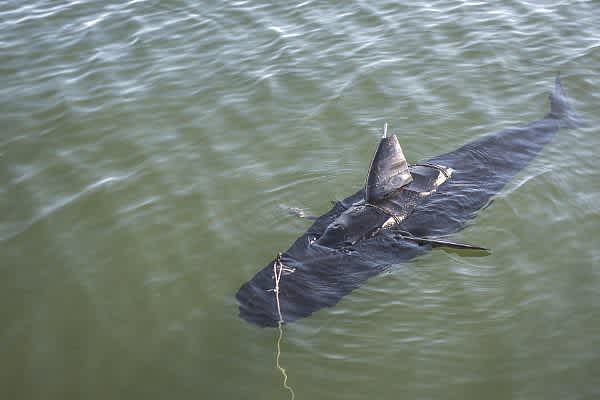The US Navy’s New Aquatic Drone is a Cross Between a Tuna and a Shark
OutdoorHub Reporters 12.16.14

Weighing in at 100 pounds and measuring five feet long, a device dubbed the “GhostSwimmer” is the newest piece of technology in the US Navy’s arsenal. The “silent” aquatic drone is one of the first working prototypes in the Navy’s “Silent Nemo” program, a project named after the clown fish of the same name in Disney’s Finding Nemo. GhostSwimmer is built like a cross between a shark and bluefin tuna, and according to a Navy press release, is much quieter than a comparable drone with rotating propellers.
What makes the GhostSwimmer special is its array of fins, which allow it to swim much like a fish does. The Telegraph reported that because it is powered by its own body movements, the device will be harder to track through traditional methods such as sonar. Its maneuverability also makes the drone useful for a number of roles, such as sniffing out sea mines, inspecting ship hulls, or squeezing through areas that are too small or tight for larger vessels to access.
“The idea is to take millions of years of evolution,” the project’s manager, Marine Corps Capt. Jerry Lademan, told the Daily Press. “This fish has perfected itself by swimming around the water for millenia, so what we are trying to do with this project, [through] the idea of biomimicry, is to reverse engineer what nature has already done to optimize design for us.”
The drone is capable of operating in waters as shallow as 10 inches and as deep as 300 feet. A large on-board battery means that the robot will also be able to run for extended periods between recharging. After many months in development and nearly $1 million in spending, officials said the drone could be integrated into the fleet as early as next year. The Navy currently has no plans to equip the aquatic drone with weapons systems, but stated that further applications could be found for the device, especially when it comes to duties that could jeopardize human divers.
“Our mantra is ‘you have permission to be creative.’ We want our people to go out there and dream big dreams and put them into action,” said Captain Jim Loper, department head for Concepts and Innovation at the Navy Warfare Development Command. “We want to see projects like this replicated throughout the fleet. The fusion of the deckplate brainpower with support of the most senior leadership in the Navy is going to keep us moving forward throughout the 21st century.”
The drone was tested last week at the Joint Expeditionary Base Little Creek-Fort Story in Virginia last week. You can see a video from that test below:

